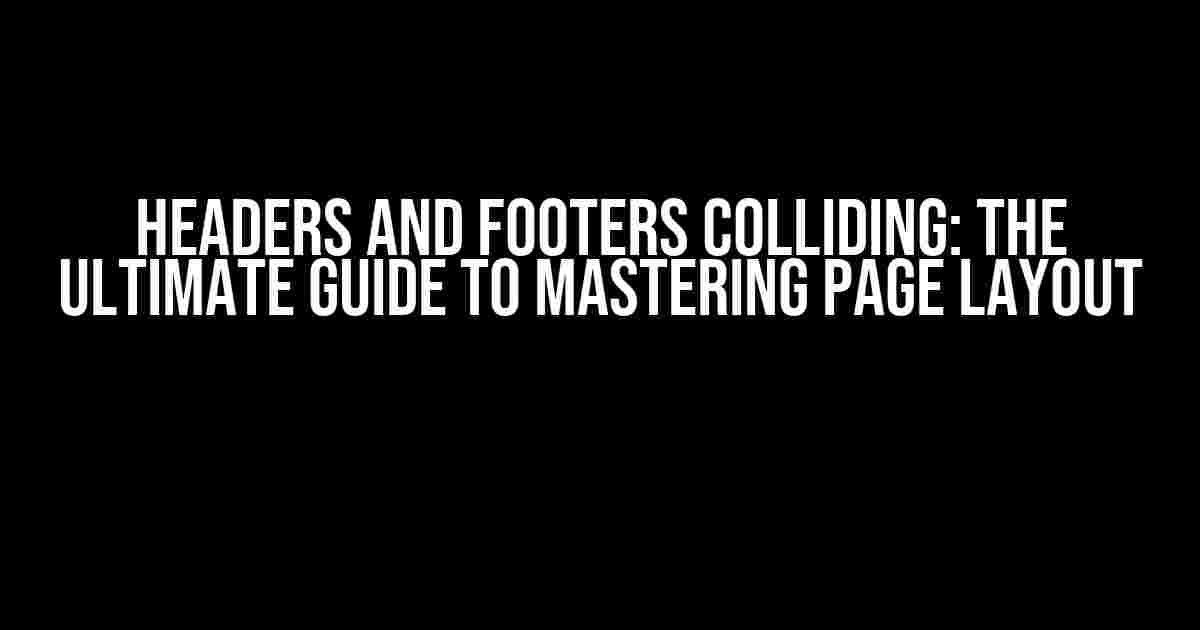Imagine a world where your carefully crafted headers and footers harmoniously coexist, without any visual conflicts or overlaps. Sounds like a dream, doesn’t it? But, in reality, achieving this harmony can be a daunting task, especially for those new to page layout design. Fear not, dear reader, for this comprehensive guide will walk you through the most common issues and provide you with actionable solutions to tame the chaos of headers and footers colliding.
- Understanding the Problem: Why Headers and Footers Collide
- Solution 1: Adjusting Margin and Padding Settings
- Solution 2: Harmonizing Font Sizes and Line Heights
- Solution 3: Positioning Div Elements Correctly
- Solution 4: Setting Container Sizes Correctly
- Advanced Techniques: Using CSS Grid and Flexbox
- Conclusion: Mastering the Art of Headers and Footers
- Bonus Section: Common Mistakes to Avoid
- Frequently Asked Questions
Understanding the Problem: Why Headers and Footers Collide
Before we dive into the solutions, let’s explore the reasons behind this phenomenon. Headers and footers colliding can occur due to various factors, including:
- Insufficient margin and padding settings: When margin and padding values are not set correctly, headers and footers can overlap or collide.
- Inconsistent font sizes and line heights: Discrepancies in font sizes and line heights can cause visual conflicts between headers and footers.
- Misaligned div elements: Poorly positioned div elements can lead to headers and footers overlapping or colliding.
- Inadequate container sizes: When the container size is too small, headers and footers can conflict with each other.
Solution 1: Adjusting Margin and Padding Settings
header {
margin-bottom: 20px;
padding-bottom: 10px;
}
footer {
margin-top: 20px;
padding-top: 10px;
}
By adding a margin-bottom to the header and a margin-top to the footer, you create a buffer zone that prevents them from overlapping. Similarly, adjusting the padding values can help maintain a consistent spacing between the two elements.
Solution 2: Harmonizing Font Sizes and Line Heights
Discrepancies in font sizes and line heights can be a major culprit behind headers and footers colliding. To resolve this issue, ensure that your headers and footers use consistent font sizes and line heights. You can achieve this by using a CSS framework or by defining a specific font family and size for both elements:
header, footer {
font-family: Arial, sans-serif;
font-size: 16px;
line-height: 24px;
}
By using a consistent font family, size, and line height, you can maintain visual harmony between your headers and footers.
Solution 3: Positioning Div Elements Correctly
Misaligned div elements can cause headers and footers to overlap or collide. To avoid this, ensure that your div elements are correctly positioned using CSS:
div.container {
width: 80%;
margin: 0 auto;
padding: 20px;
}
header {
position: relative;
top: 0;
left: 0;
width: 100%;
height: 50px;
background-color: #f0f0f0;
}
footer {
position: relative;
bottom: 0;
left: 0;
width: 100%;
height: 50px;
background-color: #f0f0f0;
}
By defining the position, width, and height of your div elements, you can ensure that they’re correctly aligned and don’t interfere with your headers and footers.
Solution 4: Setting Container Sizes Correctly
Inadequate container sizes can lead to headers and footers colliding. To resolve this issue, ensure that your container size is sufficient to accommodate both elements:
div.container {
width: 80%;
height: 800px;
margin: 0 auto;
padding: 20px;
}
By setting a sufficient container size, you can ensure that your headers and footers have enough space to breathe and don’t overlap.
Advanced Techniques: Using CSS Grid and Flexbox
For more complex layouts, you can employ advanced CSS techniques like Grid and Flexbox to manage headers and footers. Here’s an example of how you can use Grid to create a harmonious layout:
.container {
display: grid;
grid-template-rows: 50px 1fr 50px;
grid-template-areas: "header" "main" "footer";
}
header {
grid-area: header;
background-color: #f0f0f0;
}
main {
grid-area: main;
padding: 20px;
}
footer {
grid-area: footer;
background-color: #f0f0f0;
}
By using Grid, you can create a flexible and responsive layout that adapts to different screen sizes and devices.
Conclusion: Mastering the Art of Headers and Footers
Headers and footers colliding can be a frustrating experience, but with the right techniques and approaches, you can tame the chaos and create a harmonious page layout. By adjusting margin and padding settings, harmonizing font sizes and line heights, positioning div elements correctly, setting container sizes correctly, and employing advanced CSS techniques like Grid and Flexbox, you can ensure that your headers and footers coexist peacefully.
Bonus Section: Common Mistakes to Avoid
To help you avoid common pitfalls, here are some mistakes to watch out for when dealing with headers and footers:
- Not defining container sizes correctly: Failing to set a sufficient container size can lead to headers and footers overlapping.
- Not adjusting margin and padding settings: Ignoring margin and padding settings can cause visual conflicts between headers and footers.
- Using inconsistent font sizes and line heights: Discrepancies in font sizes and line heights can lead to headers and footers colliding.
- Not positioning div elements correctly: Misaligned div elements can cause headers and footers to overlap or collide.
Frequently Asked Questions
Still got questions? Here are some frequently asked questions and answers to help you out:
| Question | Answer |
|---|---|
| What is the ideal margin and padding setting for headers and footers? | The ideal margin and padding setting depends on your design requirements, but a good starting point is to set a margin-bottom of 20px for the header and a margin-top of 20px for the footer. |
| Can I use CSS frameworks to simplify the process? | Yes, CSS frameworks like Bootstrap or Tailwind CSS can help simplify the process of creating responsive layouts and managing headers and footers. |
| How do I ensure that my layout is responsive? | To ensure a responsive layout, use media queries to define different styles for different screen sizes and devices. You can also use CSS frameworks or libraries like Bootstrap or Foundation to simplify the process. |
By following the guidelines and techniques outlined in this article, you’ll be well on your way to mastering the art of headers and footers. Remember to experiment, be patient, and practice makes perfect!
- Solution 1: Adjusting Margin and Padding Settings
- Solution 2: Harmonizing Font Sizes and Line Heights
- Solution 3: Positioning Div Elements Correctly
- Solution 4: Setting Container Sizes Correctly
- Advanced Techniques: Using CSS Grid and Flexbox
- Bonus Section: Common Mistakes to Avoid
- Frequently Asked Questions
Frequently Asked Question
In the world of document formatting, there exists a pesky problem that can drive even the most patient of souls crazy. Yes, we’re talking about headers and footers colliding! Don’t worry, we’ve got you covered with these frequently asked questions.
What causes headers and footers to collide?
Headers and footers can collide when the margins of your document are set too small, causing the header and footer to overlap with the main content. This can be due to incorrect margin settings, oversized header or footer content, or even layout issues.
How do I prevent headers and footers from colliding in Microsoft Word?
To prevent headers and footers from colliding in Microsoft Word, go to the “Layout” tab, click on “Margins” and set the “Top” and “Bottom” margins to a reasonable size. You can also adjust the “Header” and “Footer” distances from the edge of the page to ensure a safe gap.
Can I adjust the header and footer sizes in Google Docs?
Yes, you can adjust the header and footer sizes in Google Docs. To do this, go to “File” > “Page setup” and click on the “Headers and footers” tab. From there, you can set the header and footer margins, as well as the distance from the edge of the page.
What’s the ideal margin size to prevent headers and footers from colliding?
The ideal margin size to prevent headers and footers from colliding depends on the size of your header and footer content. As a general rule, a minimum of 0.5 inches (1.3 cm) for the top and bottom margins is recommended. However, you may need to adjust this based on your specific document requirements.
Can I use section breaks to fix header and footer collision issues?
Yes, using section breaks can help fix header and footer collision issues. Section breaks allow you to create separate sections within your document, each with its own header and footer settings. This can be especially useful when working with complex documents or multiple-page layouts.


